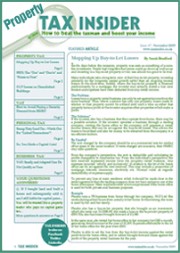Before you go, sign up to our free tax saving email course. Get 7 top property tax saving strategies in your email inbox that will help you save thousands in tax. Unsubscribe any time.
 Tax breaks are available to those that help to breathe new life into disadvantaged areas by renovating empty business premises. The aim is to help rejuvenate struggling areas and promote urban renewal. Tax breaks are available to those that help to breathe new life into disadvantaged areas by renovating empty business premises. The aim is to help rejuvenate struggling areas and promote urban renewal.
The business premises renovation allowance (BPRA) is designed to provide an incentive to bring derelict or unused business properties back into use. Under the terms of the scheme an initial allowance of 100% is available for qualifying expenditure in a disadvantaged area.
The scheme has been available since 11 April 2007. It was originally due to come to an end on 11 April 2012, but has now been extended for an additional five years, to 11 April 2017.
There are various investment schemes available which seek to utilise this relief, with hotel development proving to be particularly popular.
Disadvantaged areas
Qualifying expenditure
Qualifying building
Qualifying business premises
Certain types of building are specifically excluded from the definition and consequently from the ambit of the relief. The exclusions cover residential property and premises used wholly or partly for carrying out a relevant trade.
These are trades in the following sectors:
It is not necessary to restore an entire building to qualify for the relief. The relief is available equally in respect of part buildings. As long as the conditions are met in relation to the part of the building that is restored (i.e. it was unused for at least a year and is converted to qualifying business premises), the relief is given as for whole buildings.
The relief
The allowance is given in the chargeable period in which the qualifying expenditure is incurred.
It is not necessary to claim the full 100% allowance. Any expenditure which is not written of immediately attracts ‘writing down allowance’ at a rate of 25% on a straight line basis until the costs have been written off in full.
To prevent abuse of the rules, the allowance is clawed back if the building is sold before it is used a qualifying business premises. The initial allowance is also clawed back if the building is not qualifying business premises when it is first used by the person who claimed the allowance or when available for letting.
A balancing adjustment is necessary if a balancing event occurs within seven years of the first use of the building.
The following are balancing events:
If the balancing event occurs more than seven years after the first use of the building, there is no balancing adjustment.
The balancing adjustment can be a balancing charge or a balancing allowance and is made on the person who incurred the qualifying expenditure. The balancing adjustment is made in the chargeable period in which the balancing event occurs.
The balancing adjustment is found by comparing the residue of expenditure (basically the amount of expenditure which has not yet been written off) with the proceeds from the balancing event. If the 100% initial allowance has been claimed in full the residue of expenditure is nil.
A balancing charge arises where the proceeds are more than the residue of expenditure. This will be case if the 100% initial allowance has been claimed in full and there are proceeds from the balancing event. The balancing charge is simply the difference between the proceeds and the residue. The balancing allowance is capped at the amount of the initial allowance and any subsequent writing down allowances.
A balancing allowance may arise if the full initial allowance has not been claimed and the proceeds are less than the residue of expenditure. The balancing allowance is the difference between the two.
Case studies
Case study 1
After a year he decides to convert the basement into a health club and spa, spending a further £250,000. He is not able to claim BPRA on the extension.
He keeps the hotel for ten years, after which time he sells it for £5 million. As more than seven years have elapsed since the BPRA was claimed, there is no balancing adjustment.
Case study 2
However, he decides against running a bistro and sells the property before it is used as qualifying business premises. The initial allowance of £300,000 is clawed back.
Case study 3
After four years, she sells the nail bar for £175,000. Costs of sale are £5,000. The sale is a balancing event as it occurs less than seven years after the building is first used.
A balancing charge arises. The residue of sale is nil as the full 100% BPRA has been claimed. The net proceed of the sale are £175,000. However, these exceed the initial allowance claimed, so the balancing charge is capped at £100,000.
Practical Tip Renovating unused business properties in derelict areas can be tax efficient due to the availability of 100% capital allowances under the BPRA scheme. This is a sample article from the monthly Property Tax Insider magazine. Go here to get your first free issue of Property Tax Insider. |


 Tax Articles
Tax Articles